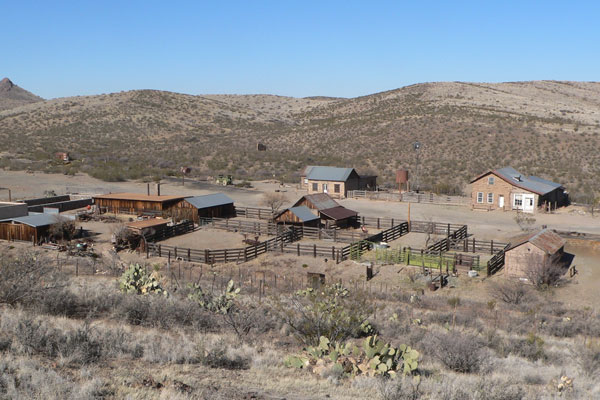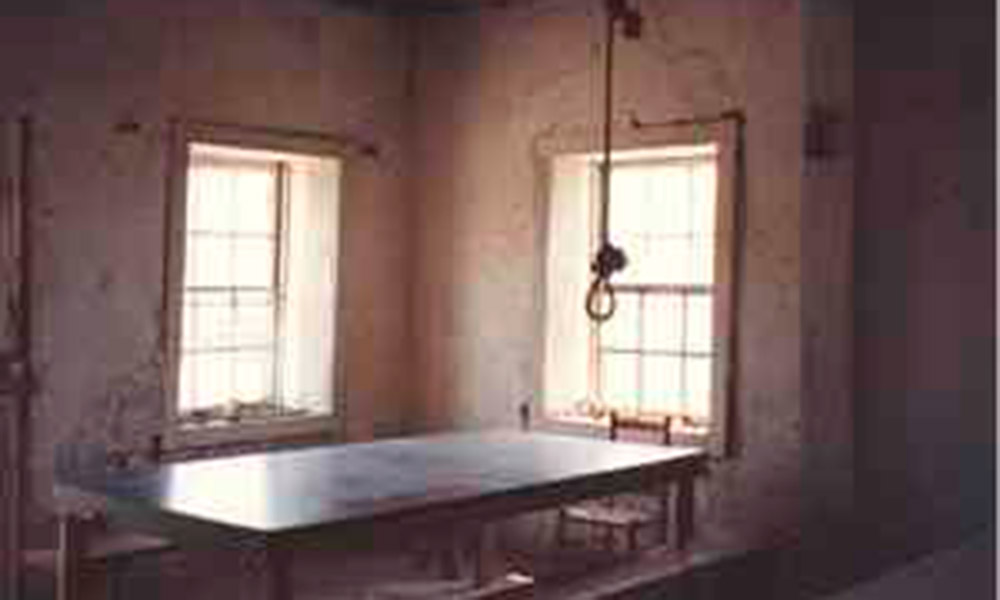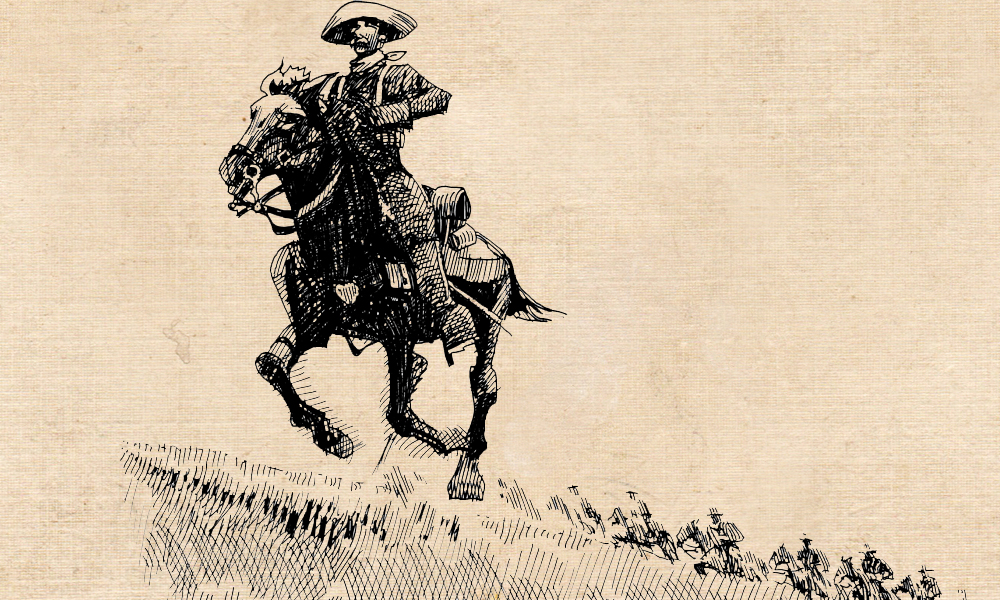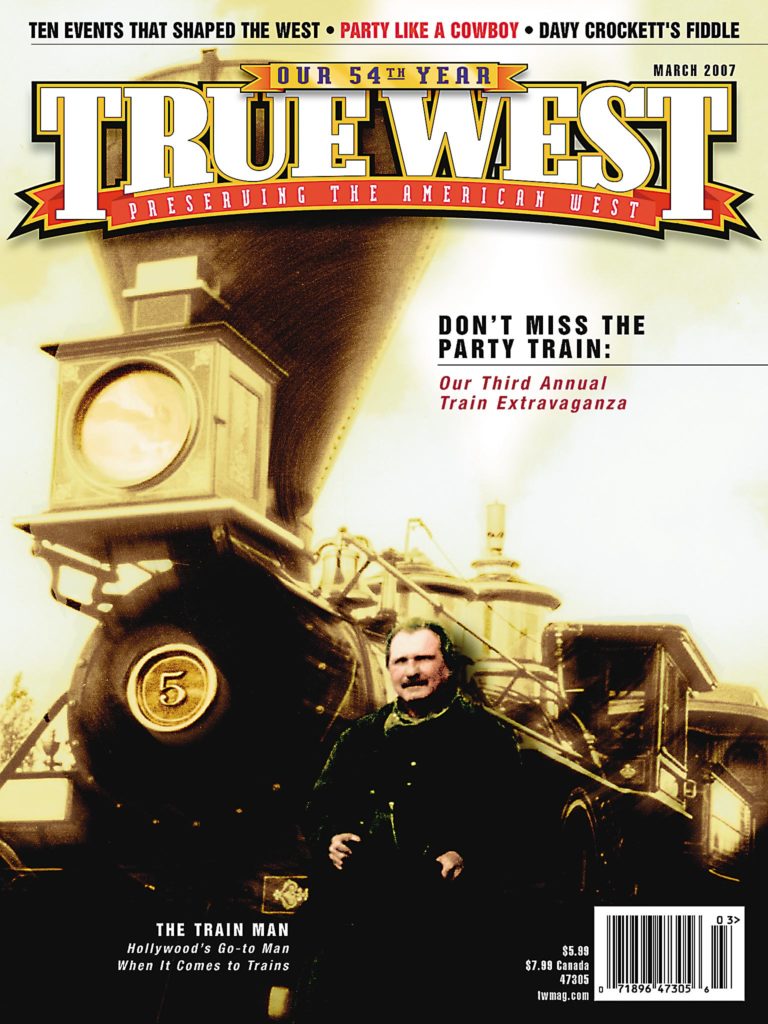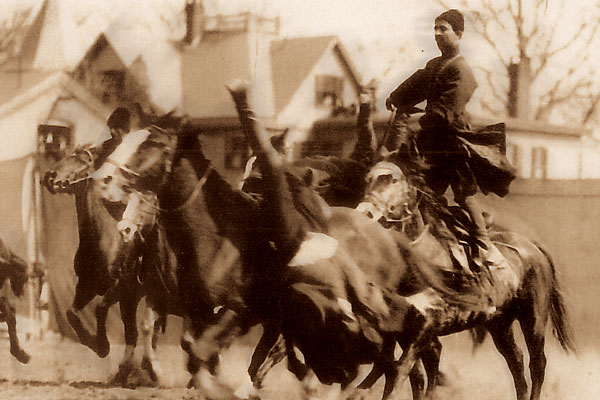
“This is not a circus but an ethnographical exhibition; the people of various nations clad in their national outfit and ammunition enact scenes sometimes in a field, at home or during battles. Imagine a circus, where more than 200 riders are incorporated into the battle scenes. The stage is so huge that riders look like ants and for that reason, organizers employ a ‘shouter’ though even he fails to communicate the messages to the public. The Circus can seat 10 to 12 thousand people.”
—Georgian newspaper, Tsnobis Purtsely, describing Buffalo Bill’s Wild West show
In September 2003, I spent two weeks in Cody, Wyoming. The Garlow Fellowship that was granted to me by the Buffalo Bill Historical Center made this trip possible. The fellowship enabled me to carry out my research about Georgian trick riders (residents of Guria, in the western part of Georgia), mistakenly labeled as Russian Cossacks, who performed in Buffalo Bill’s Wild West show during the end of the 19th and beginning of the 20th centuries.
An article about Geronimo in National Geographic triggered my interest in the subject. I had known about Georgian trick riders. I am Gurian, too, born and raised in Tbilisi, the capital of Georgia. But when I saw the Pawnee Bill’s Wild West poster with Geronimo and a portrait of Prince Luka, I wanted to find out more about Luka Chkhartishvili. Ever since, for more than a decade, my research has taken me deep into the story behind the Georgian trick riders, how they came to be associated with Buffalo Bill in the first place and what life was like for them while on tour and in the states.
Georgia
Georgia is an ancient country situated to the east of the Black Sea and surrounded by the Caucasus mountains in the north. A former republic of the Soviet Union, it shares borders with Russia, Turkey, Armenia and Azerbaijan. The history of Georgia dates back to 3,000 years. It has been an Orthodox Christian country since 337 A.D.
It is said that Georgia would not have survived without the horse and the sword. Wedged between the competing interests of multiple Empires—Roman and Byzantine, Ottoman, Persian and Russian—the Georgians were forced to fight; they were warriors. From ancient times, those who bred horses were highly respected, and good breeders were always needed and well regarded by the various Georgian kings. Although a lucrative position, it was also politically risky because breeders were responsible for providing the king with a strong and reliable cavalry.
Compared to the other parts of the country, Guria is relatively young (it is first mentioned in the annals of the 8th century A.D.). Gurian people were known around Georgia for their courage and audacity. “A Gurian is talkative, moves fast, is straightforward and hates hypocrisy,” Georgian scholar Jacob Gogebashvili states. “He’s explosive, like gunpowder, but calms down easily. Gurians are known for their bravery and swiftness, and they like to learn things.”
Bordered with an aggressive Muslim world, Georgian-Gurians had to be prepared to fight the enemy. They were also expert riders and horsemen. From generation to generation, their riding skills became more sophisticated and refined.
Buffalo Bill’s “Cossacks”
“Everyone knows him in America; there are innumerable books written about him. These books describe his life and his buffalo hunting—that made him known as the Buffalo Bill. The books also describe how he transported the mail while working at the post office, how he fought the Indians and all other adventures that had happened to him. I enjoyed reading these books, but some of these stories did not seem true to me. How can a guy kill three Indians with one shot?” This is how one unknown Gurian trick rider described his new employer, showman Buffalo Bill Cody, in his diary.
The amazing, yet tragic, history of the Georgian trick riders began in 1892, when they first joined Buffalo Bill’s Wild West show in England. In a May 28, 1892, interview granted to The Oracle, Nate Salsbury, the show’s manager, confirmed: “Yes, they arrived last night. They come from beyond Tiflis [Now Tbilisi, the capital of Georgia], near the extreme of the Caucasus Mountains.”
With this comment, Salsbury started off the trend of referring to these riders from Georgia as Cossacks. Georgia was part of the Russian empire at that time (Georgia was annexed by Czarist Russia in 1801 and by the Soviet Union in 1921), but their heritage and culture were not in any way that of the Cossacks. Even so, Wild West show and circus employers told the media that the riders came from the southern part of the Russian Caucasus, from which the Cossack family in Lord Byron’s poem, “Mazeppa,” came.
The riders played the part, too, boasting that they had been awarded medals for bravery (the stories were all a con, of course). Newspapers went even further. “The Cossacks were the real thing, right from the Czar’s army. Splendid horsemen and brave fighters, they are also fierce and cruel. They were members of the same regiment that charged upon a throng of men, women and children in the streets of St. Petersburg two years ago and shot and sabered, murdered a thousand,” reported The Hutchinson Leader on July 24, 1908. Such stories helped make them popular heroes.
On June 25, 1892, the Georgians, led by Ivane Makharadze [no relation to the author], performed in Windsor in front of Queen Victoria, the royal family and other members of the aristocracy. At a point in the performance when the Cossacks were performing their horseback work, Prince Henry of Battenberg, who was standing in the rear of the pavilion, said to the Queen in German: “Mama, do you think they are really Cossack?”
Manager Nate Salsbury overheard the prince and replied before the Queen could. “I said, I beg to assure you, sir, that everything and everybody you see in the entertainment are exactly what we represent it or them to be,” wrote Salsbury in “The Origin of the Wild West Show,” published in the July 1955 issue of The Colorado Magazine.
“It is probable that audience members were satisfied that the performers were Russian and that they could present a colorful and exciting part of the show,” wrote Sarah J. Blackstone in her 1986 book, Buckskins, Bullets, and Business: A History of Buffalo Bill’s Wild West.
Audience members clamored to see different kinds of presenters. A clever businessman, Buffalo Bill Cody decided to give them what they wanted by involving representatives of other nations in his show: Georgian peasants became Cossacks, Sioux Indians became Cheyennes or Apaches, all Indians were chiefs in the show, all Asiatic women were princesses, Army horsemen were colonels and the list goes on.
Georgian writer Tedo Sakhokia, who bumped into some riders in Paris in 1903, quoted one of them in Tsnobis Purtsely on April 16, 1903: “It’s a disgrace. No matter how hard we try to explain that we are from Georgia, they don’t get the message and call us Cossacks and don’t even want to recognize the fact that we are actually Georgians.”
Prince Ivane of Guria
“Cossack” leader Prince Ivane Makharadze wasn’t who he was billed as, either. He was no song of a king.
Group leaders for Buffalo Bill’s Wild West were mostly referred to in the lists as “Prince.” Yet only a few of the Georgian trick riders were actually of noble origin; the rest were mostly peasants. Apparently, the title was a publicity stunt to attract more people to the show.
Of all the tales told about these riders, the one most often repeated is the story of their recruitment. Thomas Oliver arrived in Georgia to locate riders for circuses in the United States. In Batumi, Oliver stopped at the home of James Chambers, the British consul. An employee of Chambers, a fellow named Kirile Jorbenadze, who was on familiar terms with some of the riders in Guria, offered help. Oliver accepted and soon the two men plus vice-consul Harry Briggs departed to the village of Lanchkhuti.
On the way there, they stopped at the village of Bakhvi, where they visited Ivane, a distinguished rider who volunteered to sign up other riders. Georgian newspaper Iveria Weekly confirmed this story in an article published in June 1892: “A visiting dignitary from England has arrived to Batumi and stayed at the councils. A fellow dressed in long, typical Georgian dress, working for a council, caught the guest’s attention. He asked the fellow to help him collect twelve good-looking, similarly outfitted fine riders. He also mentioned that he would pay good money and bring them back in six months’ time at his own expenses.”
Ivane may also be the reason why the riders selected to perform in circuses and Wild West shows hailed from Guria and not from other regions of Georgia or the Caucasus. The Georgian riders’ first acclaimed leader had spent his childhood in the small village of Bakhvi. The story goes that when he was 14 years old, his father asked him to ride to a distant village—Bakhmaro. Fond of horse riding, the young Ivane was more than happy to oblige. He rode fast until he got thirsty and dismounted at a spring. The sweaty horse, left unattended, gulped down too much cold water and died. Ivane returned to his village with only a saddle on his back and accepted a deserved thrashing from his father.
The boy, ashamed of his failure, could not tolerate his offense and ran away to Batumi. It was then 1880 and by that time, Batumi had been declared a tax-free seaport. There, he bumped into two young men who were employed on one of the ships. With their help, Ivane was introduced to the ship’s captain. The captain grew fond of the short, but lively, fellow and gave him a job. That ship weighed anchor the next day and arrived in New York harbor almost a month later. Ivane quit his job and after days of aimless wandering, he picked up another job at a bakery.
A year or so later, he surfaced as a cleaner for one of the circuses in New York. His diligence and penchant for horses caught the attention of an Arab rider employed by the circus, and Ivane had found his next job, taking care of the horses.
With his circus earnings, Ivane bought his first horse and soon was asked to perform trick riding for the circus. Clad in his national dress, he pioneered the trick of grabbing coins while riding. His successful debut allowed him to buy a second horse and become increasingly independent. Only when he had enough personal savings did Ivane dare to send a message to his parents telling them where he was living.
In 1885, before Thomas Oliver’s appearance in Georgia, Ivane returned to his homeland. So Oliver might have known about Ivane’s odyssey in America, and as a result, he knew perfectly well where to look for trick riders in Georgia.
Trick Riding Boom
In 1893, the Gurians came to the United States where, for more than 30 years, they performed under the title of “Russian Cossacks” in Buffalo Bill’s Wild West and in other circuses and shows.
“When the Cossacks came to the United States for the World’s Fair in Chicago in 1893, the Americans picked up some hints and bright ideas. From that date on trick riding had a boom from coast to coast,” wrote Frank Dean in 1975’s Trick and Fancy Riding.
Their performance began with the trick riders, dressed in their national outfit (chokha in Georgian), taking the stage while carrying their weapons and singing. They’d march around the arena, then stop and dismount on mid-stage, where they’d break into a new song and re-enact a Georgian native dance to the accompaniment of handclaps. Sometimes this dance was executed upon a wooden platform.
Then came the stunts that awoke a craze in the States. Representing the perfection of man and horse, the Georgians performed the most unbelievable tricks while galloping. Maneuvers included: standing on their heads, standing straight in the saddle, riding three horses simultaneously, jumping to the ground and then back on the horse, and picking up small objects on the ground while on the horse. A popular trick with spectators was performed by a rider at full gallop, who stood on horseback while shooting firearms.
Only a chosen few carried out the riskier moves. One such trick involved a rider removing his saddle and dismounting while riding at a full gallop. The rider would then remount, placing the saddle back on the horse. This trick riding style was called dzhigitovka (a Turkish word meaning “skillful and courageous rider”) or jiriti in Georgian.
The Wild West show’s female employees brought more grace to the Gurians’ performances. Four Georgian ladies were known to have participated in these shows in the United States: Frida Mgaloblishvili, Kristine Tsintsadze and Maro and Barbale Zakareishvili. A highlight of Barbale’s set featured her riding around with an American flag in her hands while standing on the shoulders of two galloping riders.
Western historian Dee Brown gave due credit to these trick riders, male or female, even though Brown incorrectly referred to them as Cossacks, writing in 1994’s The American West, “Trick riding came to rodeo by way of a troupe of Cossack daredevils imported by the 101 Ranch. Intrigued by the Cossacks’ stunts on their galloping horses, western cowboys soon introduced variations to American rodeo.”
Brown traced a link to the Georgian trick riders that is still found in the present day: “Colorful costumes seem to be a necessary part of trick riding, and it is quite possible that the outlandish Western garb which has invaded rodeo arenas can be blamed directly on Cossacks and trick riders.”
Some Georgian sources claimed, rather unconvincingly, that the riders rode Georgian breeds. One rider recalled how American horses needed time to get accustomed to their style of riding. Yet history shows that, at the time, it was extremely expensive to transport a horse across the Atlantic, and quarantine regulations often prohibited such transport. When asked about the use of Georgian breeds by Gurian riders in the June 1892 issue of Iveria, Ivane said: “Our horses? They couldn’t have borne the journey. We ourselves had difficulties in crossing the Black Sea let alone our horses. But we brought our saddles, our whips and the rest of the stuff.”
The riders’ Cossack saddles often attracted much attention. The Iowa newspaper, Neola Reporter, described these saddles on July 7, 1904: “Its chief peculiarity, seen from the sides, is two thin pads, fore and after, resembling loaves of bread. A closer examination shows there are four of these pads. The Cossacks stand up in their stirrups with two or three pads on, before and behind his legs. They are stuffed with horsehair. Why does the Cossack use this saddle? Prince Luka, a Georgian Cossack, could only shrug his shoulders when the question was asked him. All he could state positively was that style of saddle had been used in his native section of the Caucasus as long as human memory could extend.” These saddles were not cheap—an ordinary Cossack saddle cost $75, and the one custom made for well-known rider Alexis Georgian (Gogokhia) cost $275.
Most American newspapers commented on the Georgians’ unique riding skill. “They stood in the saddle, on their feet and on their hands and kicked their legs as the horses flew madly around. They rode standing in their saddles with their faces facing their horses’ tails and chased each other to capture a handkerchief carried in their mouth,” reported The Philadelphia Inquirer on April 9, 1893.
“Our cowboys are universally the best exponents of expert horsemanship, but the famous Cossacks are their close rival,” reported The Billboard on July 28, 1906.
“The strangely garbed Cossacks from the far off Caucasus mountains, the most expert riders in all Europe, perform feats of daring horsemanship that make even our reckless cowboys take notice and admire them,” reported the Boston Globe on June 16, 1907.
Even Cody himself said in one of his interviews, “Ride? They can ride anything, and if they get thrown they are up again in a flash. You can’t tie ’em down,” reported the New York Daily Tribune on April 20, 1902.
Culture Clash
For the most part, the Georgians interacted well with the representatives of other nations who they encountered during show business. But not always.
One of the “Cossacks” reported in his diary about a time when Georgians, Mexicans and Cowboys came to a head. “It happened in May. We began our daily exercises when Mexicans and Cowboys approached us and offered to compete against us in the rodeo. We agreed…. After a signal we started the competition, but in the second race course they fell far behind … they became infuriated and started shouting and scolding us, but how could that help them?
“A cowboy named Lyle who was not participating in the rodeo followed Aristo and struck him with his whip. Poor Aristo somehow managed to stay in the saddle. What are you doing? he shouted, but the cowboy struck him again with his whip. Aristo flew off his handle and hit Lyle’s head with the handle of his whip. Lyle fell down from his horse….
“His friends ran up and encircled us. All of them had guns, while we had only our whips. We thought the end was near, but suddenly the manager of the show appeared and separated us. Later on they realized their mistake and we made up with them.”
Competition sometimes got the best of show folk, but the Georgians were level-headed and mainly kept to themselves.
Frida Mgaloblishvili, the first Gurian woman to come to America and a Wild West show employee, stated, “We don’t socialize a lot with others and it has nothing to do with our arrogance. It’s a sort of a custom to cling to each other.”
The language barrier was an issue, as well, but even that didn’t prevent the Georgians from forming friendships. “[D]uring the Boer War, a number of wounded Boers were invited to join the circuses…. While they performed for Buffalo Bill’s Wild West show they stayed away from cowboys and Mexicans and kept company only with the Gurians. They even used to eat dinner together though they couldn’t even talk because of the language barrier,” reported the Tsnobis Purtsely on April 12, 1903.
On the whole, Georgians were accepted by show folks from other countries.
Attraction to America
Georgian riders, most of whom had never even been in their country’s capital city, Tbilisi, were seriously impressed by the Western countries, especially by the United States. Their favorite state was California. “The climate, fruit and hospitality remind us of our home country,” reported Kvali on April 16, 1903. Nikoloz Chkonia, a rider, wrote in a letter to his family: “I’ll just tell you that we have toilets made of marble stones. They look very expensive.” Kirile Khoperia told the folks back home that he lived in multi-storied buildings in which he used moving rooms (elevators) to get to his floor. Giorgi Chkhaidze wrote his family: “There are so many wires in the streets that birds often fly into them and fall down dead.”
In general, the Georgians’ decision to travel to distant lands was strictly financial—touring meant profits. On occasion, native villagers tried to bribe group leaders to recruit there since American employers paid relatively good money, up to $40-$50 per month or approximately 100 rubles. (The price of a cow in Georgia during those days was 3-5 rubles.)
The leader of the first team, Ivane Makharadze, stated: “It’s impossible for us to like the United States as much as we like our own country. We have come here just to earn more money than we could at home. We have come here only for six months … after that we will return to our wives and children.”
Luka Chkhartishvili, a famous rider, also wrote, “I have father, mother, wife and children. They all live in Russia and I have to take some money for them in winter, if I don’t break my neck, of course.”
Unfortunately, the riders were not insured against such tragic accidents. Many were hurt, and others were killed.
The Evening Times of Cumberland, Maryland, published a story on May 25, 1912, about “Cossack” Steve Graceley’s death. George Henney, a friend of Graceley’s, became injured while demonstrating a challenging trick during a break. Graceley, who had been in the riding business for 12 years, tried the same trick during a performance. He fell from his horse and was admitted to the hospital where he died on May 26. Graceley was buried at Cumberland cemetery.
Soon after, Alexis Georgian informed journalists that Graceley’s real name was Irakli Tsintsadze, and he was 52 (the reporter had stated he was 38). He had no relatives in America and apparently was deep in financial trouble; his friends had to collect the money for his funeral arrangements and to send home to his family. They managed to raise $84—$40 was spent on Tsintsadze’s burial, while the remainder was sent to his widow and six children, reported The Billboard on July 20, 1912.
Steve Graceley had done what many Georgians did; Georgians often had nicknames because their real names were unpronounceable to the show’s organizers and the public. The financial manager even had to call them by numbers on payday. Luckily, Alexis Georgian was able to identify Irakli Tsintsadze for us.
Blood and Gore, or Piglet and Ghomi?
Beyond using sobriquets, all of the participants of the show, whether they were Cowboys, Indians, Arabs or Mexicans, told journalists fictitious stories about themselves, which they would fill with blood and gore.
The Gurians were no exception. Luka Chkhartishvili told several newspaper reporters how he had killed Cossacks from the Don region, reported The Morning Journal on May 20, 1894. He told different versions of the story, with the number of Cossacks killed varying between one and 20.
Despite these tales of violence, the Georgians usually tried to behave their best in America. Every culture has bad seeds, and so occasionally, reports would crop up like this one from the American newspaper, Arkansas Democrat, reporting on October 21, 1901: “A Cossack who was drunk with red wine horrified the visitors of a Muler’s Saloon early in the morning at half past eight. He threatened the visitors with his dagger and wanted to turn them out of the saloon. His friends tried to calm him down, but in vain. A policeman came and the drunk tried to use his dagger against him as well. He was taken to the police station and they waited until he sobered up for an interrogation. As to his name, it appeared to be another problem; the only thing that the policemen understood was his first name, which they wrote down as: Theford. Unfortunately, we do not know how this incident concluded.”
Most “incidents” involving Georgians were more like the one rider Giorgi Chkhaidze shared about a few Gurians passing by some apple orchards. One of them jumped the fence, picked some apples and gave them to his friends. The next day, a newspaper article reported that some Cossacks had stolen apples. In Guria, nobody would have printed a word about a few apples taken, but in the States, the media was looking for sensational stories concerning anything related to the Cossacks. Chkhaidze recalled that the Gurians had been so ashamed, they refused to go out in public.
Those not ashamed to go out in public usually visited the restaurants dressed in their best and always kept an eye on each other in case they didn’t know how to handle an unknown dish, reported riders Kirile Khoperia and Giorgi Chkhaidze. The riders’ appetites were fascinating to journalists, who used to write how the Gurians could digest even a stone if it was served to them.
One time, the Gurians, not conversant in English, entered a canteen and asked for scrambled eggs. The waiter didn’t understand until Serapion Imnadze crouched and doodled around the place like a hen. They had scrambled eggs that day.
The chief cook of Buffalo Bill’s show stated in a June 6, 1896, interview with the Chicago Evening Post, “We prepare 800 to 1000 individual steaks every morning and serve them for breakfast…. Oh, the boys love the steaks! The Cossacks and the Indians want ’em three times a day—and they get ’em, too!”
Good food often makes for a great party, too, and Gurians knew how to throw those. The unknown Georgian trick rider wrote in his diary about one he threw in celebration of his 29th birthday. “Time has flown so quickly that it’s impossible to catch up with it. We had a small party; I invited not only Georgians, but locals as well. I bought several bottles of wine and prepared our national dishes: roasted piglet and chicken, ghomi (corn porridge) with Italian cheese, I even got our national spices. The Americans licked their fingers. Shalva was appointed as toastmaster. All of them could drink much. We talked, sang, dance, had a wonderful time and parted very late. When I saw off my guests I looked up in the sky and it was full of stars. It reminded me of my childhood, when I was in Bakhmaro, I used to climb up a pear tree and look at the stars.”
Asked by a Minneapolis Tribune reporter in 1900 what was his idea of having fun in his country, Luka Chkhartishvili responded, with many gestures, “Plenty friends, plenty wine, good time.”
A Tragic End
The First World War and the Bolsheviks ended some of the Georgians’ good times.
Those Georgians who found themselves stuck in the States, mostly in Chicago, continued performing in Miller Brothers and Ringling Brothers’ circuses, and returned to their homeland only when the war was over. Many Georgians settled down to create American families and lost ties with their homeland. In one case, a rider, married to an American woman, visited Georgia for a while. When he tried to return to the States, the Bolsheviks wouldn’t let him out of the country; he committed suicide.
As the century progressed, Wild West shows had to compete with new entertainments, such as motion pictures. Some of the shows’ organizers, including Buffalo Bill, started to make film versions of the shows. Even so, most of the shows remained in deep financial trouble due to declined attendance.
The occasional feeble attempt by some to reanimate the previous glory of the shows led to tasteless endeavors in which a few of the original Georgian participants were enlisted. But by that time, they had lost their energy and endurance. Fatally, the media had lost interest in them. The organizers even stopped mentioning their names in the programs.
Hard times were ahead for those who returned to Georgia, as well. On the grounds that they all were American spies, most of the riders were imprisoned and exiled by the Bolsheviks. Many riders had to destroy all evidence and photographs of their trips abroad in order to survive the new regime’s iron hands. Some riders were even forced to sign a document in which they promised never to mention America or Europe again.
The Bolsheviks also confiscated the precious gifts the riders had been given. Usually, these items surfaced in the houses of the Soviet party nomenclature. A daughter of the rider Pavle Makharadze recalled: “They used to take different things that had been brought from the United States from the families of all riders. Finally they took a comb and a tab from our family. My mother was so horrified that she fell ill. She was always waiting for the Bolsheviks to come again.” Nervous stress during this regime was too much for many—some committed suicide; others died in oblivion.
Despite these obstacles, the real story behind the “Russian Cossacks” could still be found, revealing how the Georgians left an indelible mark on the development of American show business, of which Buffalo Bill is considered to be the pioneer. The connection between Buffalo Bill and Gurian trick riders represents one of the oldest known relationships between Georgia and the United States of America.
Irakli Makharadze is a film director in Tbilisi, Georgia, and the co-author of Wild West Georgians, published by New Media Tbilisi, and author of Once Upon a Time in America, from diaries written by an unknown Georgian trick rider, published by Sani Publishing.


